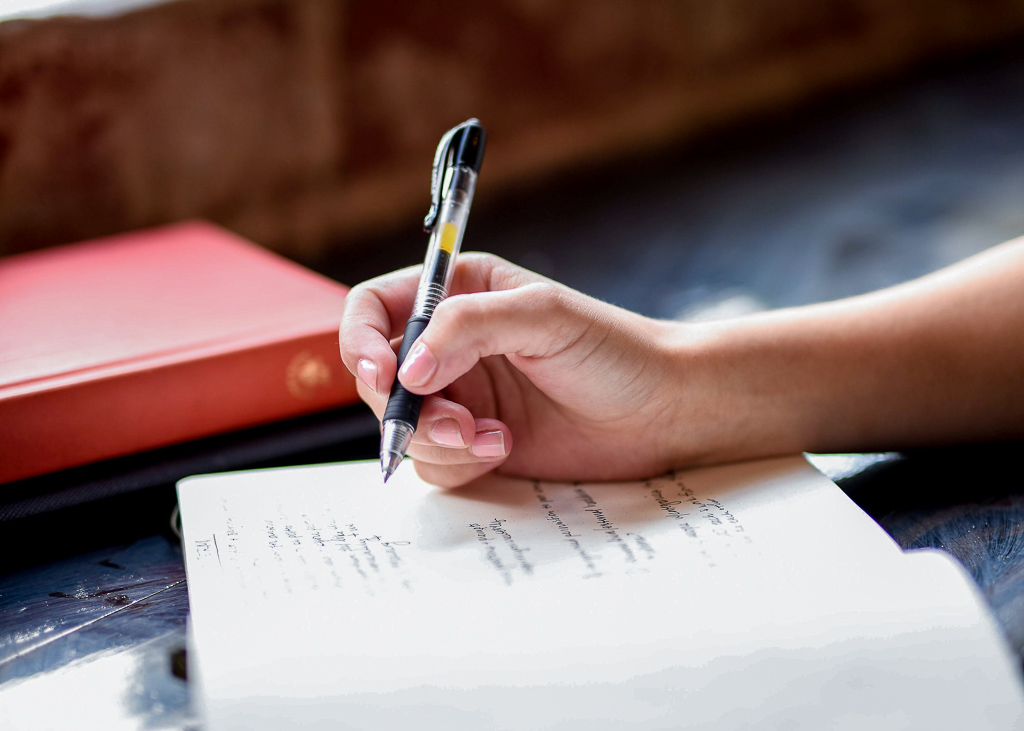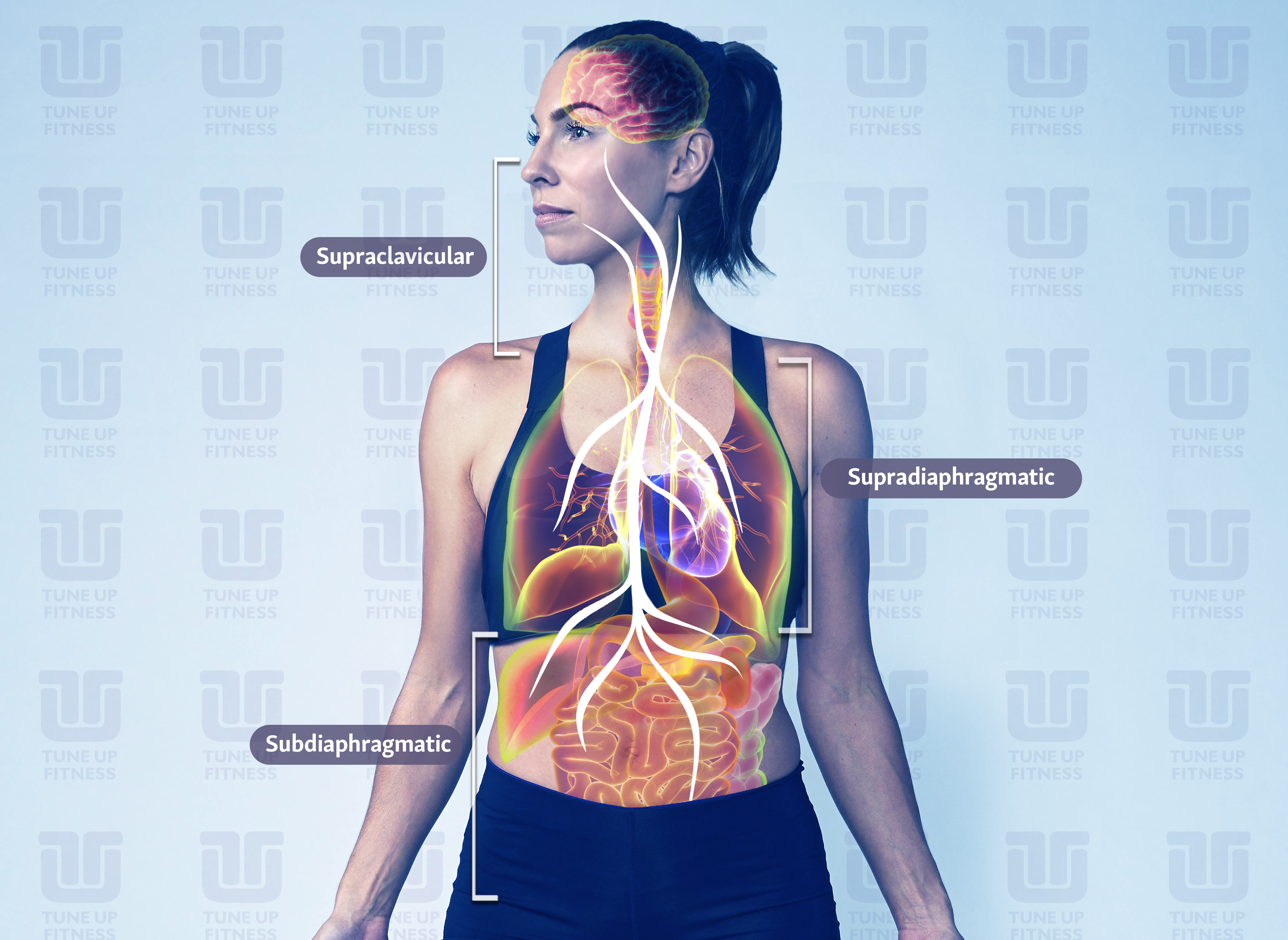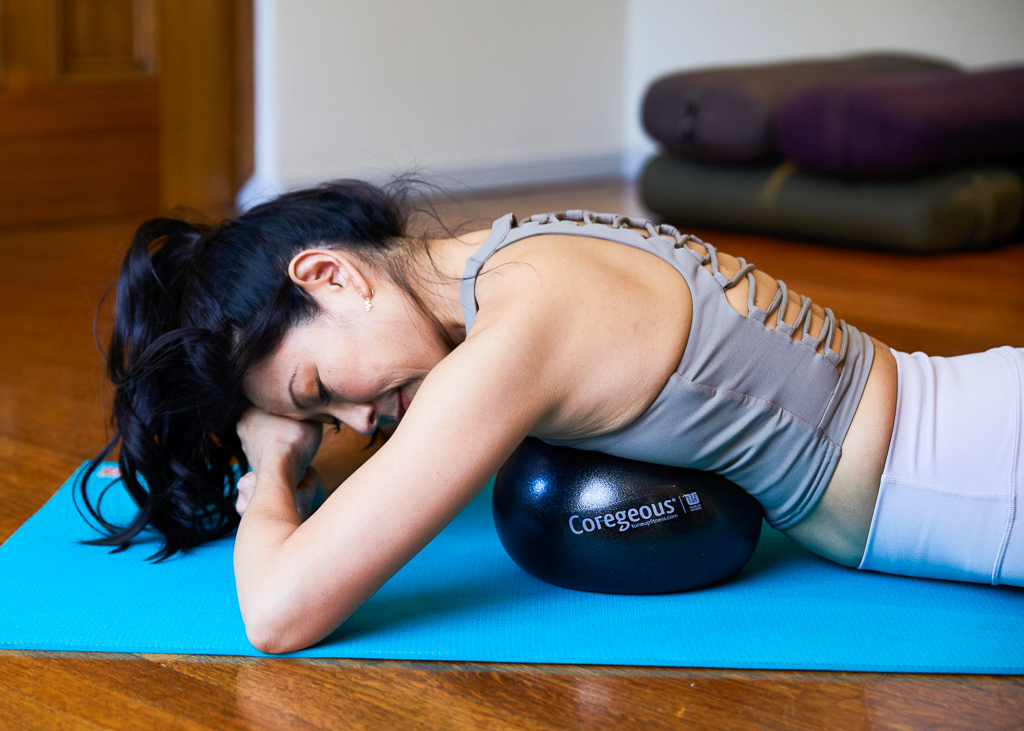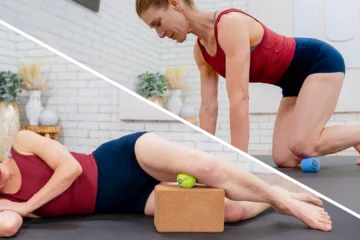
Do-at-home, no-equipment-needed, non-invasive therapeutic skills are indispensable for effectively managing stress, anxiety, exercise burnout, pain and more.
The following three self-care skills and accompanying practices will help you understand and transform your experience of pain.
Self-Care Skill #1: Notice Your Pain Vocabulary
Pain may be a response to a physical injury, but did you know that emotional reactions can also cause physical pain? Emotional reactions are linked to pain areas in the brain.
Just thinking of the word “pain” can elicit a pain response. No thank you.
This is why updating our pain vocabulary can help us transform pain by reorganizing our bio-psycho-emotional relationship to pain.
Here’s another benefit to changing our pain vocabulary: Not only are we expanding our vocabulary, but in order to do so, we must listen to and name the sensations we are feeling. It’s interesting how often we skip this step and hop right over to p.a.i.n.
It turns out that we have almost 200,000 words in English, so it’s confounding that we overuse the word “pain” as much as we do.
Pain is a spectrum of sensation and as such, our verbal expression of our sensations should reflect that.
If you hear yourself talking about your pain all the time, begin to identify other words you can use besides the “p” word.
Try this:
Reframe Your Pain Vocabulary
Monitor your self-dialogue. Each time you’re about to describe your discomfort, take a deep breath, close your eyes and focus on the location and sensation that you are feeling. After taking some time to feel that sensation, name it something other than “pain.”
On your phone or in a notebook, start a list of all the different sensations your body is trying to communicate with you.

Here are some examples of other ways you might describe your sensation: discomfort, ache, strain, fatigue, catch, spasm, tight, burn, pinch, stab, throb, twinge, poke, sting, sear, itch, pierce, hurt, swollen, burn.
Below you can continue updating your vocabulary through the self-massage practices on therapy balls.
Self-Care Skill #2: Get to Know Your Vagus Nerve
There’s no better way to tune in to your body, down-regulate, decompress and recover from injury than by re-prioritizing your nervous system.
Your vagus nerve is the head honcho of your nervous system; it rules and regulates every vital system in your body.

Breath practices, micro-movements, and self-care can help you restore your vagal tone and bio-psycho-emotional resilience, which is key for pain management.
Chest Decompress Self-Massage Exercise
Lie, face down with a Coregeous® Ball (or a small, firm pillow) under your chest and ribs. It should be in the middle of your sternum. Alternately, if this position with your bodyweight on the ball is too intense, you can stand with the ball between your chest and a wall.

Let your shoulders slouch so that your arms cascade to the floor around you. You’re aiming for the majority of your body weight to envelop the ball.
As the ball presses into your ribs, it will massage your heart, lungs, esophagus, diaphragm and oh so many of those vital nerves! However, it might not be pleasant at first.
As you ease into these instructions, listen to and name the sensations you are feeling. Describe the sensations you’re feeling to yourself.
- Breathe normally for about two minutes
- Inhale into the ball, retain your breath as you tighten up your muscles, slowly exhale
- Repeat 3-5 times
- Gently rock, left to right, seesaw-style over the Coregeous® Ball
Come off the ball slowly and take your time reorienting to an upright position. Which sensations did you feel? Add to your vocab list.

Self-Care Skill #3: Update Your Sensory Input
The following client story is a great example of how pain skews our proprioception-to-nociception (body sense and “pain” sense) relationship:
After a period of being pain-free, my client’s back pain suddenly returned. After careful assessment, we identified that her pain always returned just after teaching spin classes. Additional intake inquiry revealed that whenever she wore her microphone pack clipped to the back of her pants, she’d have back pain.
At first, we thought “perhaps it’s the electricity?” but we soon figured out that the headset cord leading to the microphone transistor pack kept tapping her low back as she rode.
It didn’t hurt, but due to her chronic pain history, all sensory input to that area was automatically being processed as pain. We repositioned her audio equipment and her back pain went away.
Can you think of a time when you experienced some startling sensory event and you said “ow” even though it didn’t hurt?
Together with retraining our pain vocabulary, we can also re-condition our sensory awareness and change our experience of noxious stimuli so that it no longer registers as pain.
Shortly after I became certified as a Yoga Tune Up® teacher in 2010, I experienced debilitating back pain. The pain was overwhelming and it made exercise impossible.
Rolling on therapy balls provided new, non-threatening sensory stimulation, increased blood flow, and improved my embodiment so that I could exercise again.
Try this:
Low Back Self-Myofascial Massage Rollout
This Low Back Rollout simply uses the Roll Model® therapy balls to massage achy, sore, tight and otherwise cranky muscles and fascia.
Another benefit if you’ve been stuck in cycles of pain, is that you can use self-massage on therapy balls as a way to re-stimulate nerve endings. Gradually, gently, you can recondition how you sense physical touch.
Once again, as you practice this technique, also try to pinpoint the best possible words to describe the sensations you’re feeling. Listen to and name those sensations.

- Stand next to a wall
- Place an Original, PLUS, or ALPHA therapy ball above your waist, beside the lumbar spine
- Rest your weight into the therapy ball and take several breaths
- After you have acclimated to the sensation, rock your body right and left
- Continue until you sense a change in your lower back (greater ease, less tension, more sensation, pleasantness, etc.)
Conclusion on Managing Sensations of Pain
Keep the following guidelines in mind when sensations of pain arise in fitness and life.
- Be patient with yourself.
- Be realistic about your timeline for healing.
- Expect setbacks.
- Continue to find novel ways to fine-tune and understand your the vast spectrum of sensations that you deal with on a daily basis.
- Rest as needed but keep your eye on the prize, which is to keep moving so that you can return to your daily activities.
- When in doubt consult a trusted doctor or specialist.

During the month of August we are sharing educational articles and interviews to help navigate the challenges and struggles brought forth from living amidst a pandemic. Our intention for sharing this curated list is so that you may learn new skills (or revisit old ones) to take care of your nervous system and incorporate breath, movement and mindset practices to increase emotional resiliency. We invite you to take what works, and allow the rest to fall away.
If you liked this article, we’ve curated a list of practical how-to’s, interviews, and more on mental health and emotional resiliency:
- How to Raise Self Awareness by Meredith Amann
“The unexamined life is not worth living” Socrates. Many people agree awareness, like mindfulness, is a skill, but could it be our hidden super power? - Learning to Say NO as an Act of Self Care by Kate Hamm
Just like yoga, saying No is a practice unto itself. - Compassionate Insight: Shifting How We Define Resilience by Emily Pantolone
Interested in building emotional resiliency? Self-compassion may be the entry point to expanding your perspective. - How to Approach and Support Mental Health When You Aren’t A Therapist by Ariel Kiley
Dr. Christopher Walling discusses mental health and the scope of practice for fitness, yoga and wellness teachers.
Related Article: How to Slow Down and Restore Full Power
Learn more about our Therapy Ball Products and Programs
Interested in video and blog content targeted to your interests












As someone who’s lived with chronic shoulder pain for the last 2.5 decades, I’m fascinated by the approach (which is novel to me) of working to re-frame what we call pain as an approach to retraining sensory awareness. It’s not an approach I’d heard of before and definitely want to try.
We humans can have a lot of judgement about our pain, sometimes (often?) being angry at ourselves. I appreciate the guidelines at the end of the article that emphasize being patient with one’s self. Taking time to notice and assess pain, and consciously changing vocabulary helps us to step back and be an observer of our experience. I thing that also noticing and naming places in the body that feel neutral, or good, could help widen perception so that its not just focused on pain.
I love the notion of upscaling our pain vocabulary. I think that expanding our pain vocabulary might naturally lead to more curiosity about sensory input. For example, if I say, “I’m so pissed off!”, it’s a general expression. But if I say, “I’m frustrated because…” its more specific and I’m curious about the input that led to the frustration. Also, the next time I feel frustrated, I might be able to peel those layers back a bit more. So perhaps these two self-care skills interweave.
The idea of updating our “pain vocabulary” is genius—it’s amazing how simply changing the words we use can alter our experience of discomfort. I love how it also emphasizes the power of the vagus nerve in calming our entire system. The practical tips on self-massage and body awareness are not just helpful; they’re empowering tools that anyone can use at home. They changed a lot in my movement routine.
I try not to even say pain in my classes anymore instead I use the word sensational. It really does make how we think about sensations in the body. How we choose to name and label them. And the often negative energy we have about them when they arise. That’s one thing that I found really wonderful about another article on here, the interview with Dr. JenFit. She said something about honoring and celebrating your pain as it’s the body’s natural alarm system. Imagine your house catching on fire while you’re asleep. Without that alarm system there is no telling how long it would take till you woke up or if you ever would. We should be grateful that our body has a way of letting us know when things aren’t going right and take the time to listen. I often equate pain to a small child tugging at your shirt. It’s just the body’s way of telling you to pay attention.
I’ve already read some on the bio-psycho-emotional relationship to pain and though I don’t see “pain” as much in my own usage I do see it in my husband and kids. For myself, I also know that I’m hyper aware of areas where I experience tension, ready to head down the rabbit hole of habit tensions. I will definitely try some of these techniques with my family, especially my husband who struggles with uninterrupted sleep since our children were born.
This article brings to mind the concept of finding interesting words that Jill mentions “Actions: The Actors’ Thesaurus” in the Yoga Tune Up Teacher Training. It also brings mindfulness, compassion and presence to our pain. Separately–so interesting that the placement of the ball with bodyweight on it could massage your heart, lungs, esophagus, diaphragm and oh so many of those vital nerves. Is that different with different sized bodies? Are these nerve sensors mostly available in this area of the body–perhaps elsewhere?
Thank you. This article is particularly relevant for me this week because I am in acute shoulder pain – and trying to find ways to navigate to more comfort. I will use the Coregeous/vagus activating chest rollout in the morning. As I fall asleep, I am considering more nuanced words to explain the changing sensations I feel in my shoulder – tingling, aching, even releasing as I lie down to rest. I like this way of “investigating” and “feeling” and “embodying” and will use the tool of pain language refinement with clients and myself.
Expanding pain vocabulary is such a useful tip for sharing with clients that deal with discomfort in the body – I will definitely be encouraging my clients to describe uncomfortable sensations in a more specific way than to use the catchall “pain.” I’m very fascinated by the story of the spin instructor as well. I wonder if inputs such as holding the body certain postures can have the same effect? The body has some interesting mechanisms it will utilize in trying to protect itself.
Finding alternative words to p.a.i.n. is going to be a new practice for me. One of the first questions I ask my bodywork clients is “where are you experiencing pain?”. I’m going to reframe this and begin offering alternatives and encourage my clients to do the same. The rollout series offered immediate relief and I’ll keep working on these. Thank you!
Very nice perspective. Our choice of words can influence our perceptions. If we relabel “pain” and begin physical calming and movements then we can hopefully get more of a sense of control which should help us move forward.
I really like the practice of slowing down and tuning into the actual sensations we usually write off as pain. I think the vocabulary list is a great idea dn good tool to use with my clients so I can better understand what they’re experiencing and so that they can better understand themselves. So often we jump back from a sensation thinking it’s pain and avoid something when we are hypersensitized overstimulated, so slowing and calming the nervous system down to reacclimatize ourselves to sensations is a great step in healing the body.
Such a good read with beautiful reminders sprinkled throughout the blog! Pain (and its spectrum) can be such a wonderful teacher/ guide. In my own body, pain has come, has gone, has lingered, has returned… It’s a never-ending relationship (for as long as I have a body I would imagine). As a teacher, I am often asking people to distinguish the difference between pain and discomfort– and I think the exercises above would be a great way to elaborate on my class– including take-home tools for continued study and healing!
It’s truly interesting how the body can shake back into the way it was before an adjustment, or class that stabilizes a painful issue. It’s also interesting how many people want a one time fix without stopping, or taking the time to notice what they did in the first place to accumulate the issue suddenly, or with time. Just as acupuncture, massage, chiropractic, or any other form of self-care they need to be used as upkeep unless the root-cause is going to change, and the outcome is going to change. Same goes with Acne. It’s pretty simple, but us humans want the diet pill per-say to drop all the weight instantly and have our ideal body. Same goes here, we cant expect miracles to last after an hour of a YTU class, but we can take time to have introspection and research ourselves further in order to discover where the pain may be occurring, and how to resolve it over time with dedication.
Pain patterns are so complex and the healing journey is multifactorial. I often hear people say “my bad side” or “my bad hip”…these statements are so powerful in the way we perceive pain, I always encourage people to STOP addressing their own bodies in diminishing or offensive ways. So much of the healing path is to create new patterns, bring new information, and eliminate the known causal factors. Our nervous system is so incredibly smart but we are also so often stuck in our ways – so important to create new pathways of information in our bodies.
j’aime beaucoup votre série d’articles sur la résilience émotionnelle et la santé mentale et celui-ci sur la douleur apporte une autre approche de la douleur. Merci
Self-inquiry is so important when it comes to pain, especially the ability to characterize one’s pain, notice changes over time (including why one has pain).
“Just thinking of the word “pain” can elicit a pain response” so powerful and so true! We often view pain as this terrible thing and want the pill or quick fix to immediately get out of it rather than observe and figure out the root cause(s) of the sensations felt. More importantly, noticing our vocab around pain and the bio-phycho- social relationship! Love the down regulating exercises as well- This article is a must read!!
Thank you for identifying the neurological sand trap inherent in living with chronic pain. Developing discernment in pain sensation has been key in my personal story, and I’m impressed by the tips. Can you elaborate on tools you utilize with students to encouragement them to remain patient with themselves?
Pain is such a broad term used by so many people. It’s almost a shortcut to bypass the true feelings or sensations that come up in the body. I think identifying and naming the pain other than pain, really understanding the feeling behind the pain can change the relationship to pain. You can see the stories attached to pain. Words are so vital to naming the experience and we do cut ourselves short by skipping over what we are truly experiencing.
Emotional reactions and having knowledge of the body is so key! I am constantly encouraging my friends whom are parents to teach their children the real terms and definitions of our bodies.
Very interresting. The power of words, to often negleted. I will change my lexique for pain. Thank you
Great post! It’s very nice to see that you answer to all people!
Hi! I agree that we need to change our vocabulary about pain and the balls can help to do that be cause they gives us this feedback. It help you to be more focus on sensations and less on pain.
Thank for this article!
Interesting to see the power of the words we use. I will think about it next time I have neck pain.. I never really though about what exactly are my sensations.
Working on the nervous system with the coregeous ball is very helpfull for me.
Thanks for the article. I am very touched to see that you are taking the time to answer everyone’s comment !! That’s very thoughtful of you 🙂
thanks for your perspective on what pain actually is and how we can otherwise define it. I have had a mini pain in my neck for about 1 year and I would love to know more about how it can be connected to emotions! Thanks for the tip on the vagus nerve technique with the corgeous on the sternum!
It is very interesting how the use of certain words like pain can induce reactions in our body. I find myself saying ”Ouch” too when I hit something, but sometimes am not even hurt. I will pay attention to it! Thank you!
Une vocabulaire positif et honorable envers notre corps peut certainement dissocier les sensations douloureuses ou négatives inscrites dans une région particulière de notre corps. merci d’éveiller nos consciences
Breath practices, micro-movements, and self-care can help you restore your vagal tone and bio-psycho-emotional resilience, which is key for pain management.
Wow, the power of words!! Thank you for this wake up call. Plus, your routine for the lower back is simple but really efficient.
Yes! I had to overcome this ‘pain’ association in areas where I have been vulnerable and injured in my past. I still have fears of reinjury, so my work continues with needing better vocabulary to describe what I am feeling.
Love the idea of changing our vocabulary to help us to be more in tune with our bodies. Thank you!
I deeply appreciate the prioritizing of dealing with the mind-scape first and using the mind to reorient away from such a triggering word as pain and its tendency to amplify a sensation. This can encourage people to use rolling more often.
I appreciated the Dineen’s tip on self-reflecting on our pain response and how it may be linked to physical pain. Such a great point on how this insight on seemingly related unconscious connections may be exacerbating our pain response. Personally, I have witnessed numerous times in my Pilates career that clients come in looking beaten, battered and defeated, often voicing how stressed their week has been at work, or how their kids have been driving them crazy and as the movement session progresses and hands on cues guide them deeper into their own movement practice, suddenly they release unwanted tension and gradually begin moving more fluidly. It is as if their emotional attachments to the things that matter so much in their life lose the forced grip that the mind holds over them. Sometimes moving it out can release that unconscious connection that often exacerbates our physical stress and pain responses.
As Dineen states, listening to and naming the sensations we are feeling bring us to higher awareness over what is happening within our own system. Sadly, we often skip over this step, focusing on our pain and crying out. It can be so difficult to turn our attention inward and listen. So much hidden data is waiting to be found and serves as a key toward unlocking the answer in how to manage the pain. I love the tips the author gives on redefining our pain vocabulary, the helpful exercises no how to manage pain, and the self-care skill in updating our sensory input. Pain needs a context we can identify and engage ourselves within our own passionate dance of life. Learning how to treat ourselves like a partner in that process is so valuable. We must learn to step outside of ourselves and look inward.
Pain vocabulary! What a great idea to reframe our habitual labeling, and in doing so, reframe our experience. The breathing exercise you recommend is one of my favorites, and always leaves me feeling calmer. Thank you for your insights.
I have experience this pattern many times, both in myself and in my students and clients. People that are not connected to their bodies and are new to movement will often label “deep stretch” as pain. I love your suggestion of expanding vocabulary to get them feeling for the truth of it. Personally, this happened to me after chronic nerve compression in C4-C5. Even years after I healed, I would go on high alert anytime there was unique sensation in that area. My theory is that if we go looking for what we consider pain, we will find it. However, if we go looking for pleasure, we will find that too!
Thanks Dinneen for this article. Too many times clients will say “I’ve got pain…..” I ask them to describe the “pain” and rename it , and usually it is not even a sharp pain, just a tightness or discomfort. I love your idea of expanding your vocabulary and rethinking what we perceive as pain or something bad.
This article is so helpful, especially for working with students and expanding their vocabulary to better tease out what’s really going on and for the tips to help shift the perspective and sensory information. Thank you for this great insight!
thank you for this article on pain. so many students say pain as a quick way out of the exercise.. this helps open the conversations more
Very insightful! Loved the incorporation of the vagus nerve and mindfulness.
Great food for thought on guiding students into a different mindset to be students of three bodies. Thank you.
Very well said! Our perceptions of pain and expectations of pain are very unhealthy…a pill ? does not fix pain. Likely will lead to other problems
So interesting everything;
Using the correct name for incomfortable sensations and sometimes change the way to said some feeling. As you said, describe your sensation using these words: discomfort, ache, strain, fatigue, catch, spasm, tight, burn, pinch, stab, throb, twinge, poke, sting, sear, itch, pierce, hurt, swollen, burn.
I would like try for a while in these order: first step. 1.- stop calm and let to by your self deeply (some times using Roll Therapy method) 2.- Re frame, change a name, and use what if ? dinamic… i mean for example; what if is just my somatic nervous system, what if is an injury, what if is and old input injury 3.- Try for a new sensory input, mentally or using propioception aids at list and check prior and re check after.
To answer your question: “Can you think of a time when you experienced some startling sensory event and you said “ow” even though it didn’t hurt?”
One day my partner & I were in the kitchen together. I picked up an empty frying pan from the stove and turned to set it on the counter, bumping it into his arm. He immediately jumped and yelped, “OUCH!”. It was only after this reaction that he realized he wasn’t in any pain at all because the frying pan wasn’t hot at all. 🙂 It was a conditioned response to his mind thinking the pan was hot.
I find this article very interesting, so many times we are in pain but we don´t even notice it or we let it pass by and we decide to continue with our busy life. I think that putting a name to our pain makes it more real and in order to heal that pain is important to stop , label that pain and take action with self care practices like the ones you share in this article, so thanks for sharing !!!
Knowing pain and the real meaning it has on your body is a very important task that we all must learn to develop, people aren’t aware about it and its importance. Knowing and learning that I could name my pain sounds logical but I’ve never thought about it before nor even thought about the ways it could benefit my life and not only physicaly but also emotionaly, I will be putting more attention on it when it happens.
Dinneen, I have definitely had times all throughout my life when I’ve said “ow” to some sensory input that didn’t actually hurt, and I always wondered why I felt the urge to say “ow”. I am very excited to re-condition my sensory awareness with the use of Yoga Tune-Up therapy balls. I’m looking forward to trying your suggested Coregeous Ball exercise especially. I’ve had asthma since fifth grade, and this seems like a great way to experience different sensation in the chest and lungs, while providing my nervous system with such a beneficial practice that restores vagal tone and improves bio-psycho-emotional resilience. Thanks so much for this post!
Our body operates in mysterious ways! Sometimes there is no “perceptive” link in between our daily activities, thoughts & emotions but just as our fascia permeates every tissue inside us, everything is intertwined too on the outside! I loved your focus on the way we describe pain, because pain is such a complex – sensation, feeling, thought, memory,…what other words?! – experience! This approach really help us learn to describe our state and being realistic about it. Thanks for sharing!
I really love what you’re saying about coming up with new vocabulary in regards to the word “pain”. It is almost like going to the end range of a pose immediately, without discovering what it’s like before we get there. I also truly appreciate what is said in reference to sensory input. Does it really hurt, or are we just conditioned to feeling pain in a certain scenario? Hmm.
It is interesting to realized how the words can affect that much our nervous system and the way we experience the world and our own sensations… I will re-think the way I process and interpret what I feel and will try to use new words to name it… thank you
Great article! Pain science is a very complex area and we must approach pain with bio-psycho-emotional lens as you mentioned here. I had a student that when she came the first day to my class, she told me she had injured herself in yoga, that she left yoga for a while and started swimming and the pain was gone and she wanted to try yoga again, curiously she started to feel pain a week after two classes, and she stopped again. After some days she was in dance classes and she was feeling no pain. I realize she had linked her pain memory to yoga and any yoga activity would cause her pain. Thanks Again!
Super interesting Dinneen! As someone who studied linguistics and second language learning in grad school, I find it so interesting to utilize our own vocabulary skills to truly identify sensations that we are feeling. I think it can be really easy to label something with the umbrella term “pain” if it feels uncomfortable, novel, different, or simply actually does hurt. However, it’s quite a challenging practice of patience to be in this state and be able to assess “How does this feel?” and craft a word that is perhaps insightful into the sensation that we are actually feeling and then from there figure out what would be best for us. I like the exercise with rolling as practice to identify words for us because I definitely feel all sorts of things depending on what is being rolled! Thanks!
There is so much more to learn about pain or should I say unlearn about what we are told about pain . I believe that a lot of pain is stored In the subconscious mind from suppressed emotions and I have witnessed it personally in one of my children who suffered debilitating pain in the abdomen from fear and not a physical ailment , to the point of not being able to walk . Wich we worked on together in releasing these emotions and fast forward 20 years later has become a yoga instructor and positive spiritual mentor also working in schools to help children so I understand how Sankalpa is part of the practice of achieving this mindful movement
I find this information very interesting, having lived with chronic pain for over 30 years before being diagnosed. Since I had surgery to finally get rid of the pain, the standard pain I had is gone, but I still experience a similar pain sometimes. I wonder if it’s a conditioned response as you write in this post. Since my pain was abdominal, I’m wondering if I can come up with another exercise for skill #2 in this post… lots to think about here!
I think this is a terrific example of running towards an experience rather than running away from it (sometimes easier said than done). Understanding not just the presence of my discomfort, but it’s nature, it qualities, its habits, its language, its favorite dessert. All key when it comes to seeking sustainable resolution. Getting curious about my discomforts and spending enough time with them to frame them in a way that they can become more nuanced and less binary – on or off, present or absent.
I’m into it.
I really loved this blog post. I just recently finished Embodied Anatomy and I have been studying trauma, shame, performance anxiety, and movement for many years now. I make wellness videos for stage performers. My most recent studying on the practices of Marisa Peer has been revolving around the word and dialog that what have for ourselves. How impactful that dialogue, positive to negative can have on the body. “Pain” so a topic I believe we all can relate to. As I’m slowly beginning to reshape the internal and external language I never thought to attach that mindset to the sensations of the body. Thanks so much for opening up this window in my mind that gives me another point of view into the house that is my body.
I really like the low back Self-Myofascial message Rollout routine, it is very effective!
Awesome post, Dinneen! I tried re-framing just yesterday while I was at the dentist having some work done. Rather than ask for more numbing, I asked the dentist to help me remember to breathe. I was also noticing my reaction to the noise, vibration and fatigue from having my jaw opened for so long. Understanding that numbing was not going to address how my physical body was responding was helpful. Also remembering that I have the tools of my Yoga Tune Up therapy balls to address any soreness in the jaw helped me stay focused. Thank you for helping us learn how to change our mindset.
Yoga, tuneup and guided meditation have all helped me be more educated in my own body and my response to ‘pain’. Rather than instantly reacting, being more of an observer to understand what is really going on.
Yoga, tuneup and guided meditation have all changed my relationship to ‘pain’. It has made me more educated to my body’s response to different sensations and has made me shift from reacting to simply observing to understand what is going on.
Such important advice and techniques to help bring mindfulness and non-judgemental awareness to pain. The more we get to know our body through mindful movement and proprioception, the more we can reduce the way we identify with and manage pain.
Very interesting post! Makes me aware of how I describe my own pain and aches… will finetune my ‘pain’ words. Thank you Dinneen!
Such a great reminder. I have alleviated a weird, highly sensational, m uscle clench that I sometimes get under my ribs by lying on my Coregous. Ball. Is one of my, and my students, favourite tool. Always get a round of cheers when I pull them out for s class
What a great post!